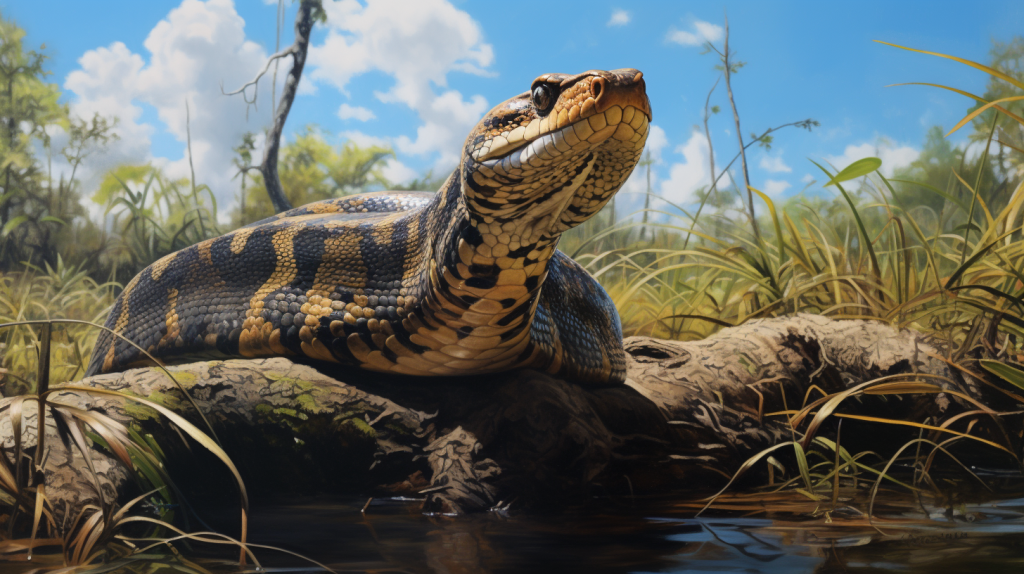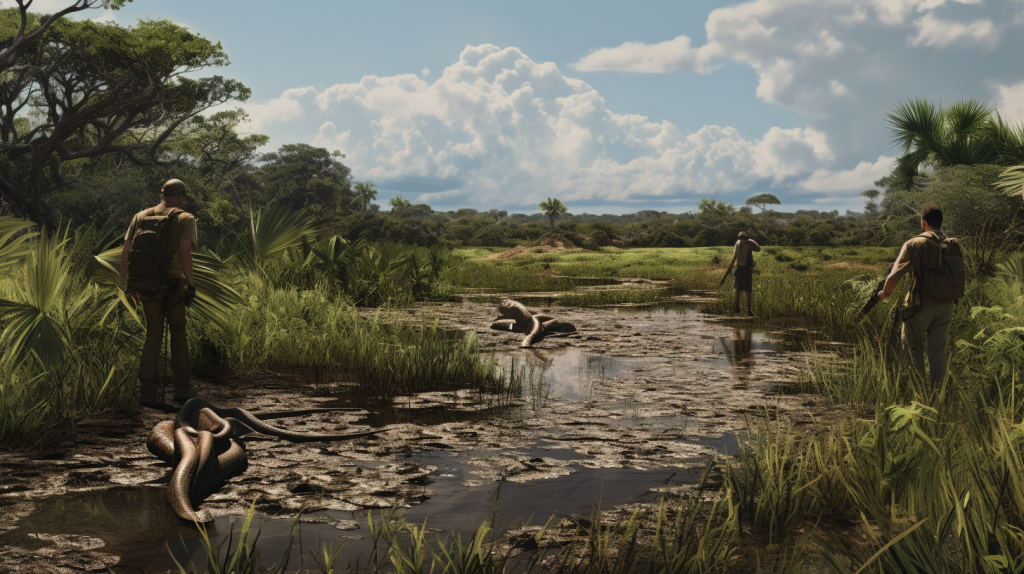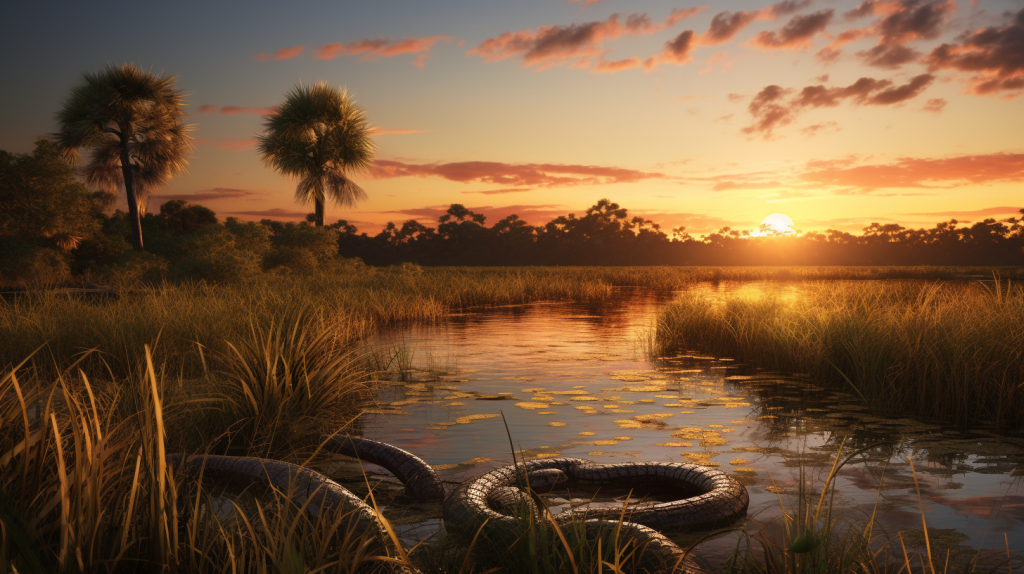Florida’s idyllic landscapes have long been a haven for nature enthusiasts and wildlife admirers, but with invasive snakes in Florida causing havoc, things are changing. However, beneath the surface of this paradise lies a silent invasion that threatens the delicate balance of ecosystems. Invasive snake species, often introduced through accidental or deliberate human actions, have found a home in the Sunshine State, posing a significant threat to native wildlife and biodiversity.
The Uninvited Guests: A Roster of Invasive Snakes
Burmese Python (Python bivittatus): Florida landscape, the Burmese python’s presence serves as a poignant reminder of the unintended consequences that can arise from the exotic pet trade. Originally embraced for their striking patterns and seemingly docile demeanor, these pythons embarked on a journey from admired companions to prolific invaders.
Their introduction into the state’s ecosystems has ignited a population explosion that reverberates through its delicate fabric. With the potential to grow beyond an astonishing 20 feet in length, these giants cast a shadow that eclipses their surroundings. Yet, their size is not their only attribute that captures attention; it’s their insatiable appetite that sets them apart.
African Rock Python (Python sebae): Among the roster of invasive snakes, the African rock python emerges as another formidable contender that adds complexity to Florida’s ecological landscape. Hailing from distant shores, this exotic python species holds a dual reputation—both for its imposing size and unwavering strength.
While its origin might lie beyond the state’s borders, its influence has seeped into its terrain, triggering concerns that reverberate through the fabric of native ecosystems. Standing as a testament to the intricate dance of survival, the African rock python’s exceptional size and power render it a formidable predator, capable of exerting dominance over other species. In this fierce competition for resources, the native inhabitants find themselves pitted against an adversary whose prowess knows no bounds.
Rainbow Boa (Epicrates cenchria): Crossing continents and borders, the rainbow boa’s unexpected arrival in the heart of Florida has triggered a symphony of concern that echoes through the state’s diverse landscapes. Originating from the vibrant tapestries of South America, this exotic serpent species now finds itself entangled in a landscape quite unlike its home. With its striking iridescent hues, the rainbow boa’s presence paints a vivid picture against the backdrop of Florida’s unique ecosystems.
However, this captivating appearance belies a deeper truth—a truth that raises questions about the implications of its presence for the local inhabitants and the intricate web of life they call home. As the rainbow boa navigates a terrain that is both foreign and unfamiliar, it inevitably intersects with native species, initiating a dance of interactions that holds the potential for both harmony and disruption.
Green Anaconda (Eunectes murinus): Emerging as a true titan among invasive species, the green anaconda’s presence in the tranquil wetlands of Florida has sent ripples of concern coursing through the hearts of conservationists and ecologists alike. Revered for its colossal size and commanding presence, this invasive serpent species has carved a place for itself within Florida’s delicate ecosystems, a place that raises questions about the very fabric of these watery landscapes.
Hailing from realms distant and exotic, the green anaconda’s colossal form casts an imposing shadow on its surroundings, leaving an indelible mark on the habitats it now calls home. However, its stature is only one facet of its intriguing story; it’s the manner in which this behemoth navigates the intricate aquatic habitats that captivates the imagination. As the green anaconda weaves through the waterways, its interactions with aquatic prey and the broader food web paint a narrative of adaptation and competition.
The Domino Effect: Impact on Native Wildlife
The entry of invasive snakes onto the stage of Florida’s ecosystems is akin to an unexpected plot twist that reshapes the narrative of native wildlife. These serpentine invaders, often arriving with human-mediated introductions, take on the role of ecological disruptors that have the power to unravel the finely woven tapestry of life.
With appetites that seem insatiable and the absence of natural predators, these invasive snakes embark on a journey of unchecked population growth—an expedition that comes at the expense of the native inhabitants struggling to secure their place in the ecosystem.
This imbalance stems from a simple truth: the natives, adapted to the rhythms of their home for millennia, find themselves ill-equipped to withstand the invasion of formidable newcomers. As apex predators, these invasive snakes impose their dominance, restructuring the hierarchy of predator-prey relationships and thereby sculpting the contours of entire ecosystems.
Invasive Snake Management: A Complex Challenge
Navigating the realm of invasive snake species is akin to threading through a labyrinth of challenges, where the path to equilibrium demands a nuanced approach that melds conservation ideals with pragmatic solutions.
This intricate journey unfolds against a backdrop of urgency—an urgency driven by the realization that the consequences of inaction extend far beyond the present moment. The challenge, multifaceted and complex, beckons for a strategy that strikes a harmonious chord between safeguarding native ecosystems and implementing practical measures.
Yet, the battle doesn’t merely hinge on reigning in existing populations of these serpentine invaders; it’s a fight to prevent future entanglements that could tip the scales irreversibly.
The Battle Continues: Fighting Back Against Invasions
- Eradication Programs: State agencies and conservation organizations are actively involved in eradication programs that target invasive snake species. These programs employ strategies such as trapping, removal, and even the use of trained detection dogs.
- Public Engagement: Raising awareness among the public about the ecological impacts of invasive snakes is paramount. Community participation in reporting sightings and assisting in removal efforts can make a significant difference in the battle against these invaders.
Conclusion: Invasive Snakes in Florida
As the south’s landscapes continue to captivate, the invasive snakes in Florida issue serves as a stark reminder of the fragile equilibrium that sustains its diverse ecosystems. The fight against these invaders demands a collective effort that transcends boundaries, involving individuals, organizations, and authorities alike. By safeguarding the delicate balance between native species and invasive intruders, we can preserve the natural treasures that make Florida’s wilderness truly exceptional.
FAQs About Invasive Snakes in Florida
Q: How did invasive snakes get to Florida?
A: Invasive snakes were introduced through various means, including accidental releases from the pet trade and intentional introductions.
Q: What makes invasive snake species dangerous?
A: Invasive snakes disrupt native ecosystems by outcompeting native species, preying on them, and altering food chains.
Q: Are there efforts to control invasive snake populations in Florida?
A: Yes, there are eradication programs and initiatives involving trapping, removal, and public engagement to control invasive snake populations.
Q: Can I help in the fight against invasive snakes?
A: Absolutely. Reporting sightings, participating in removal efforts, and supporting conservation organizations are effective ways to contribute.
Q: What are the long-term consequences of invasive snake presence?
A: The presence of invasive snakes can lead to declines in native species, disrupt ecosystems, and impact local biodiversity.
References:
- Florida Fish and Wildlife Conservation Commission (FWC). (n.d.). Invasive Species: Burmese Python. https://myfwc.com/wildlifehabitats/nonnatives/reptiles/burmese-python/
- National Park Service. (n.d.). Invasive Species: Burmese Python. https://www.nps.gov/ever/learn/nature/burmesepython.htm
- University of Florida IFAS Extension. (2021). Invasive Species: Burmese Python. https://edis.ifas.ufl.edu/uw390
- Florida Museum. (2023). Florida’s Invasive Species: Snakes. https://www.floridamuseum.ufl.edu/florida-animals/snakes/floridas-invasive-snakes/
- University of Florida IFAS Extension. (2020). Dealing with Invasive Reptiles in Florida. https://edis.ifas.ufl.edu/uw475





